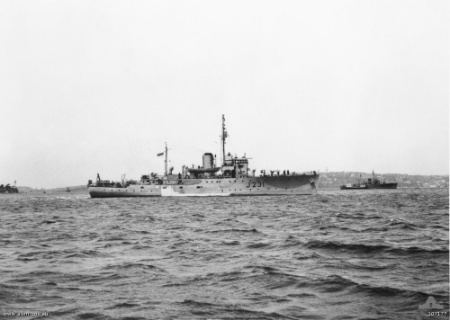Laid down 7 June 1941 Decommissioned 26 March 1946 Construction started 7 June 1941 Length 57 m | Commissioned 12 September 1942 Fate Sold for scrap in 1961 Launched 1 December 1941 Draft 2.59 m | |
 | ||
Namesake City of Bundaberg, Queensland Honours andawards Battle honoursPacific 1942–45New Guinea 1943–44 | ||
HMAS Bundaberg (J231/M231), named for the city of Bundaberg, Queensland, was one of 60 Bathurst-class corvettes constructed during World War II, and one of 36 initially manned and commissioned solely by the Royal Australian Navy (RAN).
Contents
Design and construction
In 1938, the Australian Commonwealth Naval Board (ACNB) identified the need for a general purpose 'local defence vessel' capable of both anti-submarine and mine-warfare duties, while easy to construct and operate. The vessel was initially envisaged as having a displacement of approximately 500 tons, a speed of at least 10 knots (19 km/h; 12 mph), and a range of 2,000 nautical miles (3,700 km; 2,300 mi) The opportunity to build a prototype in the place of a cancelled Bar-class boom defence vessel saw the proposed design increased to a 680-ton vessel, with a 15.5 knots (28.7 km/h; 17.8 mph) top speed, and a range of 2,850 nautical miles (5,280 km; 3,280 mi), armed with a 4-inch gun, equipped with asdic, and able to fitted with either depth charges or minesweeping equipment depending on the planned operations: although closer in size to a sloop than a local defence vessel, the resulting increased capabilities were accepted due to advantages over British-designed mine warfare and anti-submarine vessels. Construction of the prototype HMAS Kangaroo did not go ahead, but the plans were retained. The need for locally built 'all-rounder' vessels at the start of World War II saw the "Australian Minesweepers" (designated as such to hide their anti-submarine capability, but popularly referred to as "corvettes") approved in September 1939, with 60 constructed during the course of the war: 36 (including Bundaberg) ordered by the RAN, 20 ordered by the British Admiralty but manned and commissioned as RAN vessels, and 4 for the Royal Indian Navy.
Bundaberg was laid down by Evans Deakin and Company at Brisbane on 7 June 1941, launched on 1 December 1941 by Mrs. Hurwood, wife of the Director of Evans Deakin, and commissioned on 12 September 1942.
Operational history
The ship was awarded the battle honours "Pacific 1942–45" and "New Guinea 1943–44" for her service during World War II.
Fate
Bundaberg paid off to reserve on 26 March 1946, and was sold for scrap to the Kinoshita Company of Japan on 6 January 1961.
